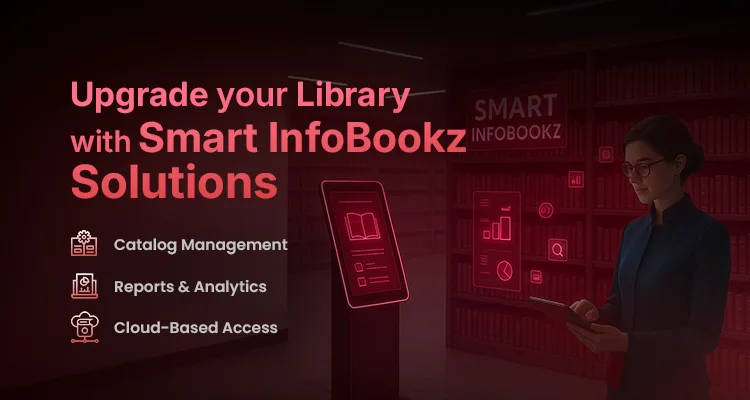What is Library Management Software?

Managing a library is a time-consuming process since it requires manual cataloging of thousands of books to track issued and returned items and keeping member records updated. Traditional methods lead to errors, delays and cause frustration among librarians and readers. This demands the adoption of an effective Library Management System (LMS). A library management software is a digital solution designed to simplify cataloging, automate book tracking, and manage member information efficiently. This solution can be utilized in schools, colleges, or public libraries, in addition, this helps in saving time, reducing errors, and providing a better experience for users.
In this blog, we will discuss in detail the Library Management System, how it works, and how the adoption of LMS in libraries benefits libraries.
What is Library Management Software?
Library Management Software (LMS) is a web-based platform that offers comprehensive library services to help organize, track, and manage library materials and other library resources in an efficient manner. Instead of relying on manual registration or spreadsheets, library management software provides a centralized platform where librarians can handle cataloging, book circulation, and member records. The objective of library management software is to streamline the daily operations of a library and reduce human error, moreover this allows readers to easily access library resources. This software can be utilized to improve the efficiency of library staff and to make the library experience of students, researchers, and members smoother. Moreover, this offers faster check-in/check-out and better resource availability.
Why Libraries Need Library Management Software
Problems with Manual Systems
Manual cataloging, ledger-based circulation, and paper-based acquisitions are time-consuming processes. Human entry of books may lead to wrong arrangement of books, incorrect borrower records, and lost items. In the absence of professional library software, backup, data protection, and compliance are difficult to maintain. Hence, this increases the risk of data loss and makes compliance harder to achieve.
Benefits of Automation and Digitization
LMS offers automated cataloging, barcode/RFID check-in/out, and batch processing to cut routine task time; this saves time and reduces human error. Moreover, LMS enables automated purchasing, invoice tracking, and subscription renewals to reduce cost leakage. In educational institutions, the Library Management Software can be easily integrated with university systems, authentication, and learning platforms to improve workflow in academic libraries. In addition, implementing library management software is a cost-effective solution, since automating manual work reduces the expense required to appoint new staff.
Growing Demand for Digital Resource Management
Universities and research libraries manage large portfolios of e-journals, e-books, and databases, which increases the requirement for a centralized and automated system in libraries. Managing the library digitally offers remote access and provides accurate book lists. Library management software provides real-time statistics on usage, circulation, and collection performance for smarter decision-making.
Key Features of Library Management Software
A Library Management Software (LMS) simplifies how libraries organize, track, and deliver resources by combining with easy-to-use digital tools. These are the main features that make LMS effective for schools, universities, and public libraries:
Catalog Management
LMS helps organize physical and digital resources in the same place; in addition, this supports batch cataloging, metadata, and digital asset management for eBooks, audio, and video. This ensure that the collections are always accessible and up-to-date.
Member Management
LMS keeps detailed records of every user, including their profile, borrowing limits, and loan history. This offers bulk data import, role-based access, and ID card integration; hence, thousands of library members can be managed effectively.
Issue & Return Management
LMS automates book check-in and check-out using barcode or RFID. It allows quick renewals, sends overdue alerts, calculates fines automatically, and that even supports self-service kiosks to make circulation faster and easier.
Search & Discovery
The Online Public Access Catalog (OPAC) lets users search and find books, eBooks, or journals. LMS makes searching easier and improves the overall user experience with features like filters, categorization, indexing, and personalized recommendations.
Reports & Analytics
LMS creates real-time reports on book usage, borrowing patterns, and collection trends. These reports help libraries make smarter decisions about buying new books, managing budgets, and improving resources.
Integration
LMS connects easily with barcode scanners, RFID gates, and online databases. It can also link with interlibrary loan systems and other institutional platforms to ensure smooth and efficient operations.
Multi-Device Access
LMS is a cloud-based system; hence, it can be accessed anytime from desktops, tablets, or smartphones. This has a mobile-friendly dashboard, which allows librarians and users to stay connected and manage operations in the library from anywhere.
Types of Library Management Systems
While choosing library management software, you must have a basic understanding of the available options. Each LMS consists of unique benefits, depending on the size of the library, budget, and technical requirements.
On-Premise Library Management Software
The on-premise Library Management Software is installed on local servers within the library or institution. On-premise library management software offers complete control over data and operations for organizations with strict compliance rules.
Cloud-Based Library Management Software
The cloud-based LMS is hosted online and accessed through the internet. It allows libraries, schools, and universities to manage resources anytime, anywhere, using desktops, tablets, or smartphones. Moreover, this is a cost-effective solution for modern libraries that want scalability and flexibility.
Open-Source Library Management Software
Open-source LMS is free to use and can be customized based on a library’s unique needs. This system can be used in public libraries, schools, and research institutions with limited budgets.
Advantages of Using Library Management Software
Adopting an effective library management system offers unique advantages that help in managing both physical and digital resources easier. Below are the main benefits that LMS offers to various institutions and libraries:
- Saves Time and Cost
LMS allows automation of cataloging, book tracking, and circulation; hence, this helps in reducing manual workload for staff. Therefore, this saves time and lowers operational costs, which makes it a cost-effective solution for schools, universities, and public libraries.
- Reduces Human Errors
LMS consists of features like barcode/RFID scanning and automated record updates. This reduces the chances of misplacing books or incorrect entries; moreover, this accurate tracking ensures smoother day-to-day operations.
- Enhances User Experience
Using LMS, students, researchers, and members can easily search catalogs, reserve books, or access e-resources online. User experience can be enhanced by the features of LMS, such as self-service kiosks, mobile-friendly dashboards, and automated notifications.
- Improves Resource Accessibility
LMS helps in managing printed books, journals, or digital media like eBooks and subscriptions through one centralized system. Thus, users can access resources through cloud-based platforms at any time.
- Scalable for Small to Large Libraries
The modern LMS will adapt to every size and type of institution. This system can be integrated into the libraries of schools and large universities. In addition, it can be scaled up with additional modules like e-resource management, analytics, or multi-branch support.
How to Choose the Right Library Management Software
Selecting the best Library Management Software (LMS) is an important decision for any school, college, university, or public institution. The adoption of the right system ensures smooth operations, cost-effective management, and an improved experience for both staff and users. Here are the main factors that you have to consider before purchasing an LMS for your institution:
- Size of the Library
The requirements of a small school library differ from those of a large university library or a multi-branch public library. Schools and libraries may require simple cataloging and circulation features, while larger ones need advanced modules like analytics, digital resource management, and multi-branch support.
- Type of Resources
A basic system is sufficient for a library that manages only printed books. An advanced LMS is required for modern libraries that deal with digital resources such as ebooks, journals, and subscriptions. Hence, a good LMS should handle both physical and digital collections seamlessly in one platform.
- Ease of Use for Staff & Students
Make sure that the LMS has a user-friendly interface that helps librarians, staff, and students to adapt quickly. Features like OPAC (Online Public Access Catalog), self-service kiosks, and mobile-friendly dashboards allow everyone to access resources without training.
- Cloud vs. On-Premise
Large institutions utilize cloud-based LMS since it provides library access from anywhere at any time; moreover, it is easily scalable and updates automatically. While on-premise LMS gives more control over data but requires higher upfront costs and IT maintenance.
- Budget
Libraries often operate with limited budgets, so it is crucial to evaluate both upfront and long-term costs. Cloud-based systems usually follow a subscription model, while on-premise solutions demand larger initial investments.
Make library management smarter with InfoBookz. From cataloging to digital resources, it is the cost-effective solution your school, university, or institution needs.
Use Cases of Library Management Software
School Libraries
Schools often face challenges in tracking textbooks, student borrowing limits, and late returns. InfoBookz library management software allows schools to easily manage student profiles, automate book issue/return through barcode or RFID, and send overdue reminders. This is a cost-effective way to keep accurate records of the books in the school library.
University & College Libraries
Universities and colleges handle large collections of books, eBooks, journals, and research papers. A manual library management system cannot handle the complex operations of university libraries. InfoBookz library management software for universities centralizes physical and digital resources, provides 24/7 access to students through OPAC, and offers advanced reporting on usage trends.
Research Institutions
Research institutions need precise control over specialized materials, digital archives, and subscription-based journals. The digital library management system of InfoBookz allows institutions to streamline e-resource tracking, manage licenses, and provide seamless search options for researchers.
Public Libraries
Public libraries serve diverse communities and must balance cost-effective operations with wide accessibility. The cloud-based library management system of InfoBookz offers self-service kiosks, mobile-friendly access, and personalized recommendations for members. The large visitor volumes can be handled by automated cataloging and real-time reporting.
Managing a library is not a challenging task. A Library Management Software (LMS) simplifies cataloging, book tracking, and member management; moreover, this makes both physical and digital resources more accessible. The right LMS ensures smoother operations for every type of library, from saving time and reducing human errors to enhancing the user experience.
LMS is not just for large universities or research libraries; even small school libraries and public institutions can benefit from automation, cost-effective management, and improved accessibility.
If you are looking for a beginner-friendly yet powerful library management solution, explore InfoBookz Library Management Software today and make your library smarter, faster, and more efficient. Contact us now.
Frequently Asked Questions and Answers
-
Is a library management system only for large libraries?
No. Modern LMS solutions like InfoBookz are scalable, and they can be applied for schools, large universities, and multi-branch public libraries.
-
Can an LMS manage both physical and digital resources?
Yes. A modern LMS like InfoBookz supports books, journals, e-books, and digital databases within a single centralized platform.
-
How does an LMS improve the user experience for students and researchers?
LMS make use of OPAC, personalized recommendations, mobile-friendly dashboards, and self-service kiosks to provide faster access to resources.
-
How can I choose the best LMS for my library?
For choosing the best LMS for your library, consider factors such as the size of your library, the type of resources, ease of use, and budget.
-
Can InfoBookz integrate with other institutional systems?
Yes. InfoBookz can integrate with barcode/RFID hardware, interlibrary loan systems, online databases, and authentication systems.


